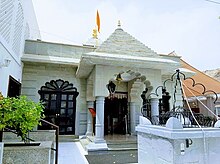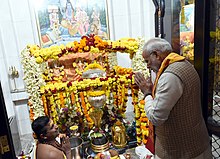Hinduism is the second-largest religion in Oman, practised by 5.5% of its population.[1]
| Total population | |
|---|---|
| 259.780 (2020) | |
| Regions with significant populations | |
| Muscat | |
| Religions | |
| Hinduism | |
| Related ethnic groups | |
| Indians in Oman and Hindus |
History
[edit]
For centuries, Muscat attracted Hindu merchants involved in various trades, including pearls and grains.[2] Hinduism first came to Oman in 1507 when Kutchi-speaking Hindus arrived in Muscat from the Kutch region in India. There were at least 4,000 Hindus in Oman in the early 19th century. In 1895, the Hindu presence in Muscat came under attack by the Ibadis and by 1900, the number of Hindus decreased to 300. During the independence of Oman, only a few dozen Hindus remained. The historical quarters of al-Waljat and al-Banyan are no longer occupied by Hindus.[2]
Demographics
[edit]Oman is the only country in the Middle East with an indigenous Hindu population. There are at least 1,000 Hindus in Oman with Omani citizenship.[3] According to the CIA, there are 259,780 Hindus constituting 5.5% of population.[1]
Temples
[edit]
There are two officially recognized Hindu temples in Oman.[4] The Shiva temple in Muscat (Motishwar Mandir) in Oman is one of the oldest Hindu temples in the Middle East region.[5] The other is the Krishna Temple, also in Muscat.[6]
Famous Omani Hindus
[edit]- Kanaksi Khimji was the only Hindu Sheikh in the world[7]
- Hemal Mehta, cricketer
- Ajay Lalcheta, cricketer
- Suraj Kumar, cricketer
See also
[edit]References
[edit]- ^ a b "Middle East OMAN". CIA The World Factbook.
- ^ a b J.E. Peterson,Oman's diverse society: Northern Oman, Middle East Journal, Vol. 58, Nr. 1, Winter 2004
- ^ Chaudhury, Dipanjan Roy (2020-01-12). "India announces national mourning for its close friend Sultan Qaboos of Oman". The Economic Times. ISSN 0013-0389. Retrieved 2023-04-05.
- ^ "International Religious Freedom Report Oman for 2011" (PDF). Archived from the original (PDF) on 15 April 2021. Retrieved 19 December 2020.
- ^ Staff Report (19 December 2020). "Modi visits 125-year-old Shiva temple". GulfNews. Retrieved 14 February 2018.
- ^ "PM Modi to visit 200-year old Shiva temple in Muscat". dnaindia. 12 February 2018. Retrieved 19 December 2020.
- ^ Runa Mukherjee Parikh (11 May 2013). "World's only Hindu Sheikh traces his roots to Gujarat". The Times of India. Retrieved 19 December 2020.